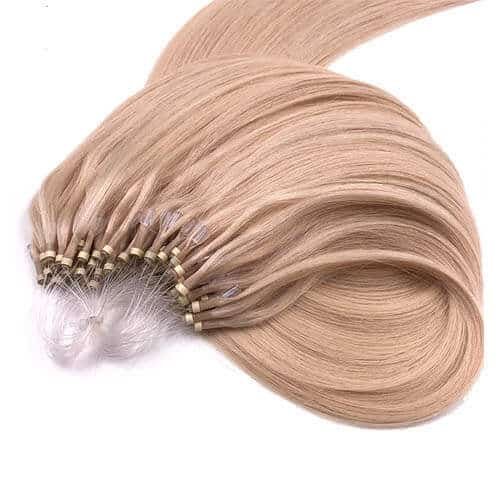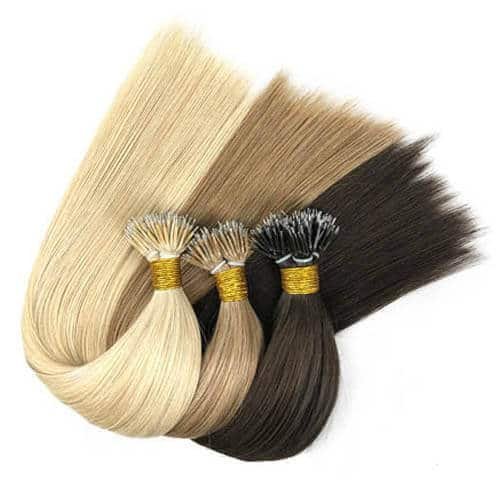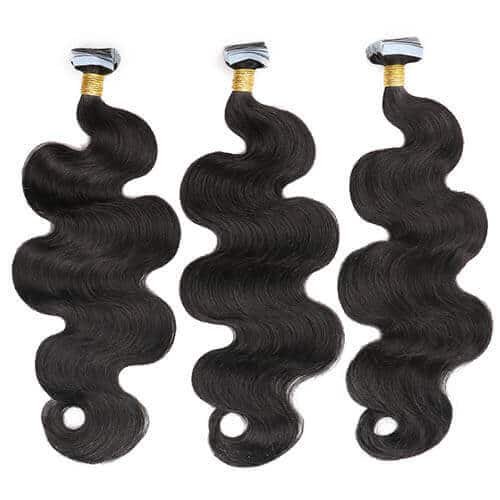Last Updated on 09/06/2025 by Eva Liu
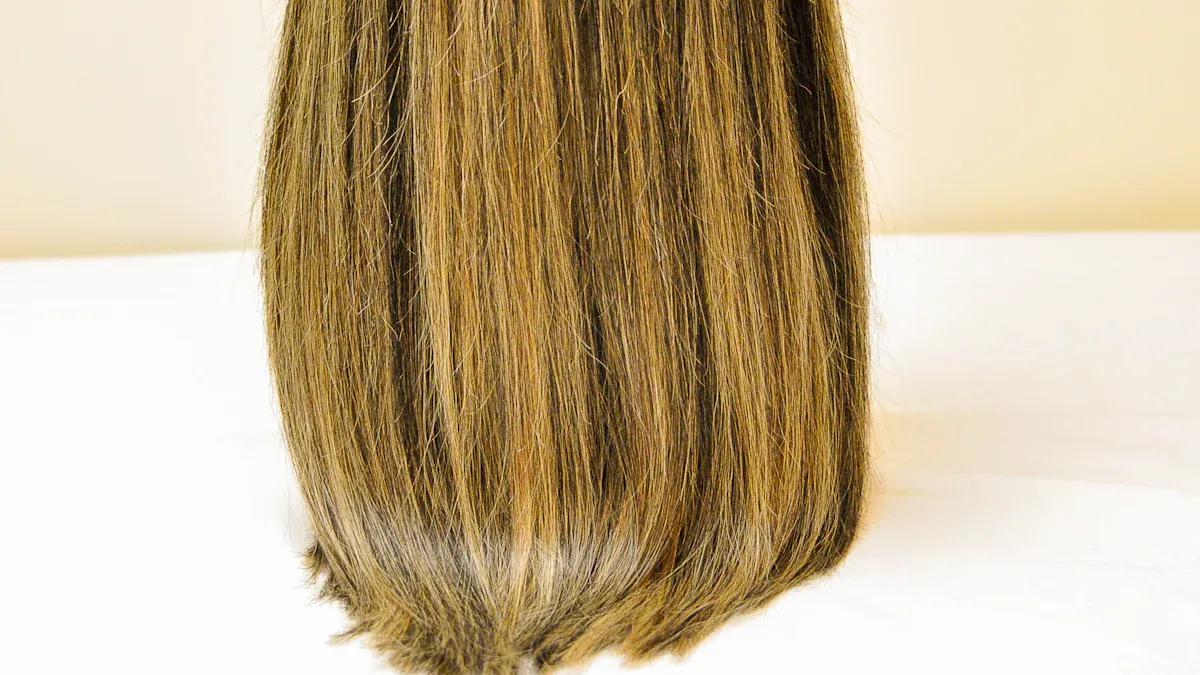
Choosing the right weight for human hair extensions helps you stay comfortable. It also keeps your scalp safe from stress. You need to match the weight to your own hair type. Think about your style goals too. This helps your hair look healthy and natural. You can compare extension weights to things you know. This makes picking the right one easier.
Factor | Impact on Comfort and Hair Health |
|---|---|
Extension Weight | Lighter choices help your scalp stay healthy |
Attachment Method | Gentle ways lower the chance of harm |
Hair Type |
Tip: Lighter extensions feel nicer and look real. They work best if your hair is fine or thin.
Comfort and Weight Basics
Why Weight Matters
You want your hair extensions to feel light. The right weight lets you stay comfortable all day. Heavy extensions can pull on your roots. This pulling can break your hair or make it fall out. Many people find lighter choices, like invisible tape or micro K-tip, work better for them. You can look at the table below to see how types compare:
Extension Type | Weight Impact on Comfort | Tension at Roots | Long-term Wearability |
|---|---|---|---|
Micro K-tip | Lightweight, high comfort | Low tension | Keeps comfort for a long time |
Keratin | Moderate weight, reliable | Medium tension | Gets softer with use, lasts well |
Tip: Pick lightweight extensions if you want to keep your scalp safe and your style neat.
Heavier human hair extensions can stress your real hair. This can cause traction alopecia, which means hair loss from pulling. You might also see your hair get thinner or break. Using long, heavy extensions can lead to non-marginal traction alopecia. Always think about the weight before you choose.
Scalp Health and Wearability
Your scalp needs looking after when you wear extensions. Heavy extensions can cause problems like redness, dryness, or irritation. You might get bumps or itching from rubbing or leftover glue. If you do not dry your extensions well, damp spots can let germs grow.
Common scalp problems include:
Scalp irritation from rubbing or glue
Dead skin and oil building up, stopping new hair
Dampness causing infections
You can stop these problems by picking the right fit and material. Try breathable choices like invisible tape. Wash your scalp often and dry your extensions fully. Many people say lighter extensions make care easier. You spend less time looking after them and feel more comfortable.
Human Hair Extensions for Thin Hair
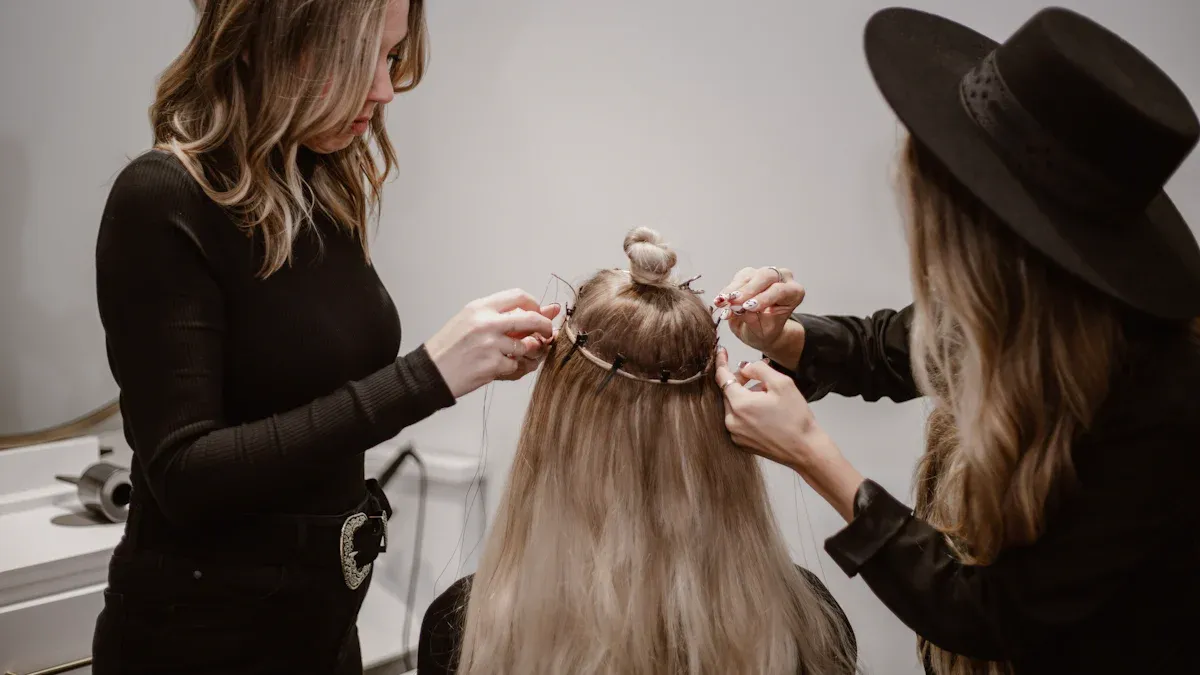
Lightweight Options
If you have thin hair, you need to choose extensions that feel comfortable and look natural. You want to avoid heavy products that can pull on your roots. Many people with fine hair prefer light-weight extensions because they reduce tension and help your scalp stay healthy. You can find several lightweight yet strong options that suit thin hair.
Here are some popular choices:
Clip-in hair extensions: You can add or remove these easily. They do not put much pressure on your scalp.
Ponytail hair extensions: These give you extra length and volume without a permanent bond.
Tape-in extensions: These blend well with fine hair and are simple to apply and remove.
Keratin bonded extensions: These offer a secure hold while staying lightweight.
Hand-tied extensions: These use thin wefts and avoid glue or heat, making them gentle for thin hair.
Many brands, such as Hidden Crown and Luxy Hair, design their products with lightweight wefts. These extensions use Remy human hair, so you can style them like your own hair. Customers say seamless clip-ins from these brands help reduce scalp tension and feel comfortable for long periods.
Tip: Choose invisible tape or hand-tied extensions if you want a natural look and easy wear.
Tape-in, Nano, Micro-link Types
You may wonder which extension type works best for thin hair. Tape-in extensions are a favourite for many people. They sit flat against your scalp and do not pull on your roots. You can wear them all day without discomfort. Nano tips are very small and light. They suit fine hair and do not add extra weight. Micro-link extensions also work well for thin hair. They do not need glue or heat, so they protect your scalp.
Users with thin hair often say tape-in extensions feel light and easy to wear. The invisible design helps them blend with your natural hair. Micro-link extensions are gentle and do not cause damage. Nano tips offer a discreet and comfortable fit.
Extension Type | Comfort Level | Suitability for Thin Hair | Application Method |
|---|---|---|---|
Tape-in | High | Excellent | Tape |
Nano tip | High | Excellent | Micro ring |
Micro-link | High | Excellent | Micro ring |
You can choose any of these options for hair extensions for thin hair. Each type gives you a lightweight feel and a natural look.
Match Weight to Style Goals
Length vs. Volume
When you choose human hair extensions, you need to decide if you want more length, more volume, or both. The weight of your extensions plays a big part in this choice. Heavier extensions usually give you more volume. If you want a fuller look, you need more hair, which adds weight. For longer hair, you also need extra weight to keep the ends thick and natural.
If you have thin or fine hair, 50 grams of extensions can add gentle length and a bit of volume.
For a dramatic change, you may need more weight, but too much can weaken your roots.
Longer extensions need more hair to stay thick from top to bottom.
Typical weights: 12″–14″ (50g–100g), 20″–22″ (150g–180g).
Tip: Always balance your style goals with comfort. Lighter options, like invisible tape or light-weight extensions, help you avoid stress on your scalp.
Full Head or Partial
You can choose between a full head of extensions or just a few pieces for a partial look. Each option has its own benefits for comfort and appearance.
Aspect | Full Extensions | Partial Extensions |
|---|---|---|
Weight | Heavier overall | Lighter, less hair |
Comfort | Can feel heavy on the scalp | Generally more comfortable |
Natural Appearance | May look less natural if too heavy | More natural due to less weight |
A full head gives you the best hair extensions for a big change, but it can feel heavy. Heavy extensions may strain your scalp and cause problems like traction alopecia. Partial extensions spread the weight more evenly and feel lighter. You can use customisation to match your needs. If you want a natural look and easy wear, matching the right weight to your style goal is key.
Note: Always talk to a stylist before you choose. They can help you find the best balance for your hair type and comfort.
Best Hair Extensions Comparison Guide
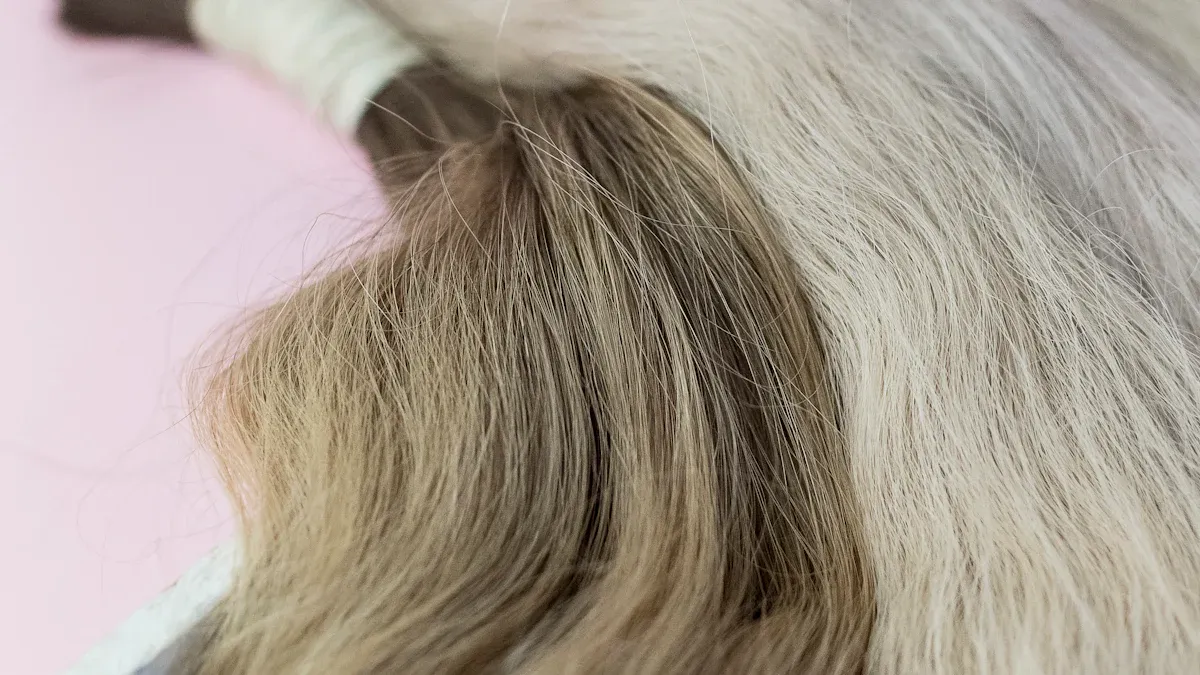
Everyday Object Comparison
It is easier to choose hair extensions if you know their weight. You might not know how heavy a set of extensions is. Here is a simple guide to help you. It compares the weight of popular extensions to things you see every day.
Extension Type | Typical Weight (grams) | Everyday Object Equivalent |
|---|---|---|
Tape-in | 50g (full head) | A large apple |
Nano | 30g (partial) | A small chocolate bar |
Micro-link | 80g (full head) | A medium-sized orange |
Tape-in hair extensions feel as light as an apple. Nano extensions are even lighter, like a chocolate bar. Micro-link extensions weigh about the same as an orange. This makes it easier to know how each type will feel on your head.
Tip: If your hair is thin, choose light-weight extensions. Nano or tape-in types will feel gentle and almost invisible.
Comfort Ratings
You want your extensions to feel soft and look natural. Many people say the best hair extensions are comfortable and easy to care for. Users often say extensions stay soft all day. With good care, you can wear them for a long time. They do not tangle much and are easy to look after. Most people find that extensions blend in well and do not hurt, even after many hours.
But you should always check how the extensions are put in. If they are too tight, you might feel pain. Heavy extensions can sometimes hurt or cause hair loss. Some people may have a reaction to the materials, which can make their scalp itchy.
The quality of the hair is important for comfort. Virgin Remy hair gives you the most comfort. The cuticles are not damaged, so there is less tangling and it feels more natural. Machine Remy hair is also comfortable but may need more care. Non-Remy hair can tangle easily and may not feel as nice.
Hair Type | Comfort Level | Notes |
|---|---|---|
Virgin Remy | High | Cuticles intact, reduces tangling, enhances natural feel. |
Machine Remy | Moderate | Generally comfortable, but may require more maintenance. |
Non-Remy | Low | Cuticles facing different directions, prone to tangling and discomfort. |
You should also think about how the extensions are put in. Tape-in and nano extensions use gentle ways. These methods keep your scalp safe and comfortable. Micro-link extensions also fit well and do not need glue or heat.
Virgin Remy hair feels soft and natural.
Tape-in and nano extensions are good for thin hair and sensitive scalps.
Micro-link extensions are great if you want a secure hold.
Light-weight extensions help you avoid pain and keep your scalp happy.
Note: You can download our infographic for a quick guide. It shows the weight of each extension next to common objects and gives comfort ratings for each method.
Weight Guide for Maximum Comfort
Recommended Weights
You want your hair extensions to feel nice and look real. Picking the right weight helps you stay comfy and blend your hair well. You should match the weight to your hair type and what style you want. Hair stylists change the weight for each person. They think about how thick your hair is, the look you want, and how the extensions go in.
Here is a quick table to help you:
Hair Type | Recommended Weight (grams) | Description |
|---|---|---|
Thin Hair | 80 | Adds volume or length with minimal bulk. |
Thin/Medium Hair | 90 – 120 | Standard choice for length and volume. |
Thick/Average Hair | 130 – 190 | Creates dramatic looks, adds significant volume. |
Very Thick Hair | 200 and Above | Not recommended; may cause stress. |
Clip-in Extensions | 60 to 100 | Best for thin hair, completely undetectable. |
Medium to Thick Hair | 120 to 180 | Ideal for fuller styles. |
I-Tip/U-Tip Extensions | 100 to 140 strands | For thin hair, 0.5 – 0.7g each. |
Medium to Thick Hair | 120 to 200 strands | 1g each recommended. |
Tape-in Extensions | 60 to 80 pieces | For fine hair, 50g each, invisible finish. |
Thick Hair | 60 to 80 pieces | 100g each for extra volume. |
Wefts | 1.5 to 2 wefts | 100g each, versatile for any thickness. |
Matching the weight to your hair helps it blend and feel good. Nano bead hair extensions are good for fine hair. They spread the weight and do not shed. Invisible weft extensions are great if you want less bulk and a smooth look.
Practical Tips
You want your extensions to feel nice and look real. Here are some easy tips to help you pick the right thickness and stay comfy:
Check how thick your hair is before you choose. Thin hair needs lighter extensions. Thick hair can use heavier ones.
Pick the extension method that fits your life. Tape and nano bead hair extensions are hidden and not bulky.
Customisation is important. Matching the colour helps your extensions blend in.
Spread the weight evenly. Part your hair in layers, starting at the bottom, so the weight is even and blends well.
Keep the strand size the same. Match each piece of your hair to the extension for a hidden look.
Space micro links or beads evenly. Do not put them too close to your scalp. This stops pulling and feels better.
Let a stylist put in your extensions. Good application stops pulling and shedding.
Take breaks from wearing extensions. Remove them sometimes to let your scalp rest.
Massage your scalp gently. This helps blood flow and stops build-up.
Look after your hair well. Wash and dry your extensions to keep them looking nice.
Tip: If you match the weight and length to your hair, you get a natural look and feel comfy. Customisation for each hair type makes extensions light and real.
You can have lovely hair with invisible weft extensions, nano bead hair extensions, or tape methods. These choices are not bulky and blend in well. Customisation and good care keep your extensions looking great.
Choosing the right weight for weft extensions keeps your hair healthy and comfortable. You should always match the weight to your natural hair. Many experts say this helps you avoid damage and hair loss. People with fine hair need to be extra careful. Use guides and tables to compare weft extensions. These tools help you see which weft extensions fit your hair best. Most people ask about how weft extensions feel at first. You may notice some pressure, but you get used to it. The number of weft extensions, your hair type, and the length all change how they feel. Lightweight weft extensions are easy to manage. Professionals suggest you try samples and talk to a stylist. This makes sure your weft extensions feel right and look natural. When you choose the correct weight, you enjoy comfort and a natural look. You can find the best weft extensions for your needs.



